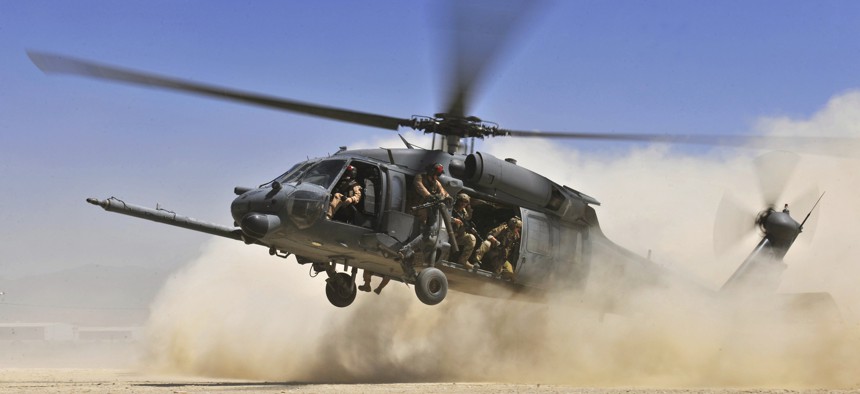
A U.S. Air Force HH-60G Pave Hawk helicopter carrying combat search and rescue Airmen approaches a landing zone during an exercise Aug. 21, 2010, at Bagram Airfield, Afghanistan. U.S. Air Force / Staff Sgt. Christopher Boitz
Tomorrow’s Downed Pilots May Be Rescued by an Osprey-Black Hawk Team
A U.S. Air Force chief of staff who was shot down over Serbia has reenergized the debate over the best way to do combat search and rescue.
U.S. Air Force officials have spent the better part of the past decade chewing over the best way to rescue pilots downed over a battlefield. But now the debate is kicking into high gear, thanks to an F-16 pilot who owes his life to combat-search-and-rescue crews: Chief of Staff Gen. David Goldfein.
CSAR units need “to be able to operate across the range of combat operations,” Goldfein told reporters Tuesday at the Air Force Association's annual Air, Space and Cyber conference outside Washington, D.C. "We need to start the dialog there because if you get set in a particular scenario, it will lead you to one particular outcome and another scenario will lead you to a different outcome.”
“In one scenario, a CV-22 may be optimal. In another scenario, an H-60 may be optimal,” said Goldfein, whose F-16 was shot down over Serbia in 1999. “In another scenario, a vehicle on the ground and a small team may be optimal.”
Such a multifaceted solution would suit the Air Force just fine, he said: “We as a service, I would argue historically and certainly currently, apply a family of systems approach to a problem.”
The debate began after the service tried to replace its worn-out HH-60G Pave Hawks, the armed Sikorsky Black Hawk helicopters used to do CSAR. After then-Defense Secretary Robert Gates cancelled the CSAR-X project in 2009, it looked for a time as though the Air Force was going to lose the entire mission as well.
But even after the service won the right to keep flying CSAR, internal debate flared anew: should the job remain with Air Combat Command, or switch to Air Force Special Operations Command, whose pilots and pararescuemen are accustomed to low-level, high-danger flights? There has also been debate over which aircraft is best suited for the mission: traditional helicopters or faster V-22 Osprey tiltrotors. (That’s not even to mention the debate over which aircraft can coordinate or provide extra firepower once the A-10 retires.)
Related: The Warthog’s Forgotten Mission
Related: One Does Not Simply Embed US Troops In Iraq
Related: UAE Shows the Air War Against ISIS Is Almost Entirely on America’s Shoulders
Meanwhile, the Pave Hawks grew older and more frail, beat up by 15 years of near-constant deployment to support combat operations in Afghanistan, Iraq and other parts of the globe. In June 2014, the Air Force tried again to replace the Pave Hawks, this time with new Black Hawks.
But Osprey partisans point to the V-22s that have been standing CSAR watch in the Mideast, waiting to pick up downed pilots bombing Islamic State militants in Iraq and Syria. In 2015, the United Arab Emirates suspended its participateion in the coalition airstrikes campaign against ISIS until the U.S. military moved Ospreys closer to the battlefield.
Goldfein has tried to move the debate away from a one-aircraft-fits-all approach.
“For me, it’s not a platform approach,” he said. “I think if we actually approach it from that perspective, we’ll end up missing the entire architecture and enterprise required to do personnel recovery in the future.”
The Air Force chief said the pararescue jumpers who fly in the back of the helicopters also train with CV-22s flown by Air Force Special Operations Command.
“That part of the business is not something we need to evolve, because we’re already doing it,” he said.
This kind of debate is healthy, said one former Air Force chief.
“It’s good to constantly look at the organization of a service,” then-Gen. Mark Welsh told reporters in June. “I don’t think you should ever just put the issue behind you and just walk away from it and forget about it because everything does change; priorities change, resources change.”
Welsh noted there are “lots of emotional opinions on this issue,” but said to expect “a resolution in the next couple of months on this particular round of the debate.”
For his part, Goldfein wants better ways to locate downed pilots.
“The future needs to ask the question: how do we get rid of the ‘S’ in CSAR,” he said. “How do we get to a point where we’re no longer searching because we know exactly where the person is? Technology should allow us to do that.”
Both Goldfein and Welsh said their service should keep the CSAR mission.
“The combat search-and-rescue mission is part of the fabric of an air force. It has to be,” Welsh said. “If I’m going to ask somebody to go fly across a border and put themselves at risk in enemy territory, I need to be able to look them in the eye and tell them [we’re] coming to get them if there’s a problem.”
Goldfein’s view: “When somebody calls for help, it’s the United States Air Force that fights its way in to get that out. That has been the case, that will always be the case, and we do that regardless of the uniform they’re wearing or the language they speak.”




